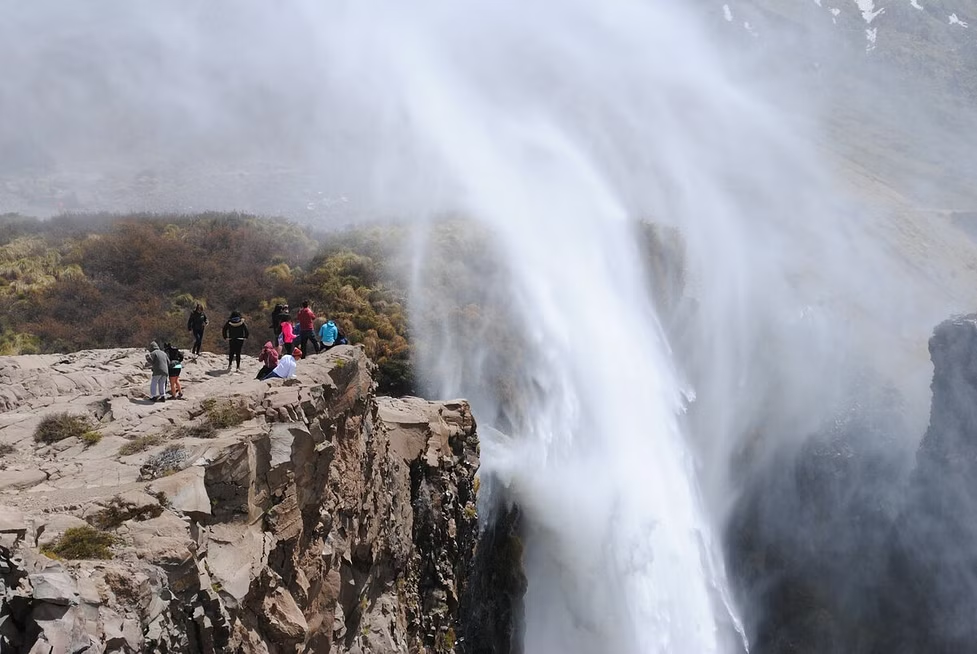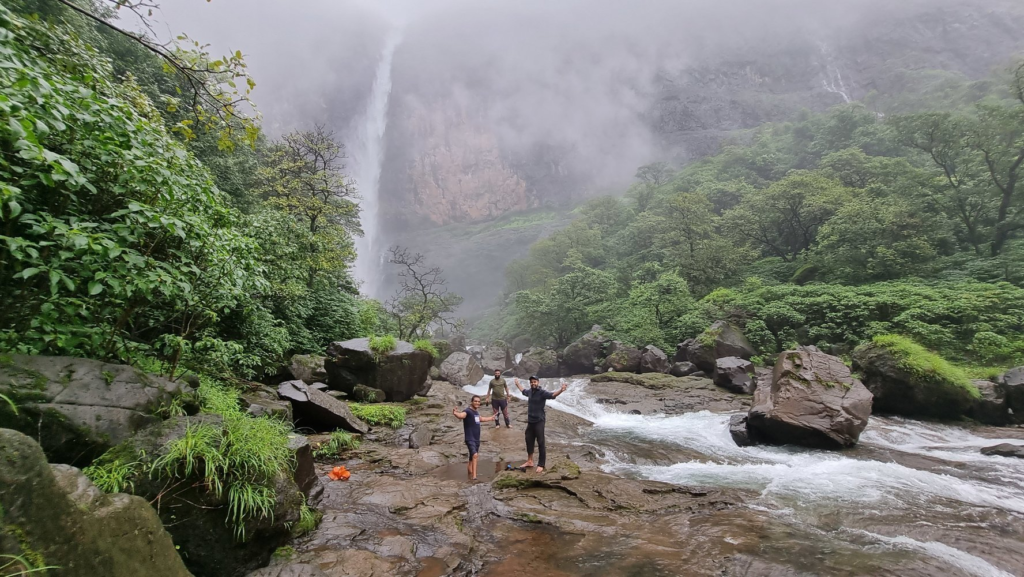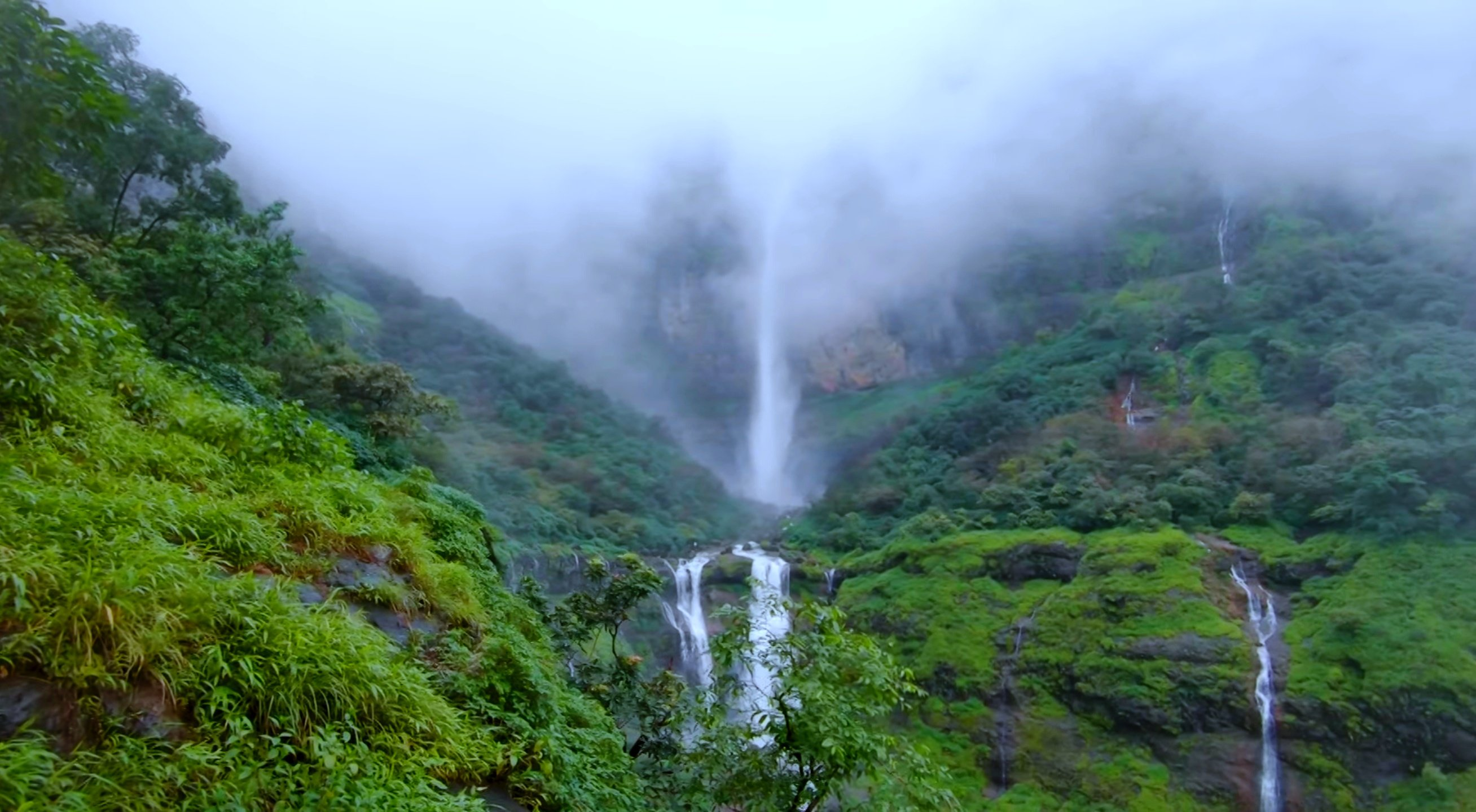Naneghat, an ancient mountain pass in Maharashtra, is home to one of the most unique natural phenomena in India—the reverse waterfall. Nestled in the Western Ghats near the cities of Pune and Mumbai, Naneghat attracts visitors with its mesmerizing sight of water defying gravity, seemingly flowing upward.
This geological marvel, combined with historical significance, trekking opportunities, and stunning views, makes Naneghat a must-visit destination in Maharashtra. Here’s an in-depth look at Naneghat’s reverse waterfall, its fascinating history, trekking details, and tips for visitors.
The Phenomenon of Naneghat’s Reverse Waterfall
The reverse waterfall phenomenon at Naneghat is one of nature’s most captivating tricks. During the monsoon season, strong wind currents from the valley blow water upwards, creating an illusion that the waterfall is flowing in reverse. The experience of watching water being pushed up against gravity, particularly during heavy rainfall, is both surreal and awe-inspiring.
This effect happens due to the unique geographical features of Naneghat, which is positioned at a high altitude within the Sahyadri mountain range. When monsoon winds meet the cliff, the force is powerful enough to propel the falling water back up.
Read : Top Ten Best Regions to Visit in 2025: Suggested by Lonely Planet
The strong, upward winds overpower the downward flow of water, resulting in the “reverse” motion that visitors see. The waterfall is most active and impressive during the monsoon months of June to September, drawing large crowds eager to witness this rare spectacle.
Read : AAAAA-Rating Chinese Waterfall Comes Under Scrutiny as Video Shows Water Flowing from Pipes
The reverse waterfall has become a major attraction for nature enthusiasts, photographers, and trekkers alike, offering a sight rarely found elsewhere in India. It is not only a natural wonder but also an ideal spot for adventurous photography and an unforgettable experience in the lap of the Western Ghats.
Historical Significance of Naneghat
Beyond its natural beauty, Naneghat holds historical importance as an ancient trade route. The term “Naneghat” is derived from Marathi words “Nane” meaning “coins” and “Ghat” meaning “pass,” which reflects its role in the past as a toll collection point. Traders used this route for transporting goods between the Konkan coast and the Deccan Plateau.
During the Satavahana dynasty, this pass was a key economic pathway, helping merchants transport goods such as spices, grains, and other valuable items.
The legacy of Naneghat’s historical role can be seen through ancient inscriptions and carvings found in the area. A rock-cut cave at the top of Naneghat features Brahmi inscriptions that narrate stories of the Satavahana period, including the achievements and lineage of rulers. Historians have studied these inscriptions extensively to gain insights into the governance, economy, and social structure of that era.

The inscriptions are written in Prakrit and Sanskrit and mention the donations and sacrifices made by Satavahana queens and kings, especially Queen Naganika, who was a prominent figure of that dynasty. For history enthusiasts, a visit to Naneghat offers a rare chance to connect with the past and explore remnants of ancient civilization in the midst of nature.
Trekking to Naneghat: A Journey Through Nature
Reaching Naneghat is an adventure in itself, as it requires a moderately challenging trek through dense forest, rocky terrain, and lush greenery. There are two main trekking routes to Naneghat: one from Junnar, which is relatively shorter, and another from Vaishakhare village, which is more popular among trekking enthusiasts from Pune and Mumbai.
The trek starts at the base of the mountain and takes around 3-4 hours to complete, depending on the starting point and the pace of the trekker. As trekkers ascend, they pass through picturesque landscapes, including waterfalls, small streams, and panoramic views of the Western Ghats.
The monsoon season enhances the beauty of the trail, with mist-covered hills, abundant flora, and the sounds of chirping birds creating an enchanting atmosphere.
At the summit, visitors are rewarded with a breathtaking view of the surrounding valleys and hills, as well as the awe-inspiring reverse waterfall. The route is relatively safe but can become slippery during the monsoon due to mud and rain, so appropriate footwear and caution are recommended.
Naneghat also serves as a great destination for group treks, offering an opportunity to bond over shared experiences and to enjoy Maharashtra’s natural beauty.

Naneghat has designated rest points and campsites along the way, providing trekkers with spots to relax and admire the scenic views. The trek is also an educational experience, as guides or locals often share insights about the flora and fauna of the region, as well as the historical significance of the Naneghat pass.
Tips for Visitors to Naneghat
Visiting Naneghat, especially to witness the reverse waterfall, is a unique experience, but it’s essential to plan well to make the most of the journey. Here are some tips to consider:
- Best Time to Visit: The ideal time to visit Naneghat is during the monsoon season (June to September) when the reverse waterfall phenomenon is most prominent. However, this is also the most challenging season for trekking due to slippery trails and heavy rainfall. For those interested in a safer trekking experience with moderate weather, October to February is also a good period, though the reverse waterfall effect may not be as strong.
- Safety and Precautions: As the trek can be strenuous and the trails become slippery during the monsoon, it is advisable to wear good-quality trekking shoes with a solid grip. Carrying rain gear, including waterproof bags for electronics and essentials, is crucial for protecting belongings from sudden downpours. It’s also wise to trek in a group or with a guide, especially for first-time visitors.
- What to Pack: Essential items include sufficient water, snacks, a first aid kit, a flashlight, and a fully charged phone. While Naneghat has no shops or food stalls on the route, carrying lightweight, nutritious snacks like energy bars or dry fruits can be helpful for maintaining energy levels during the trek.
- Respecting Nature: Naneghat is a protected natural area, and visitors are encouraged to follow eco-friendly practices. Carry all waste back with you and avoid littering the trail or summit area. Be mindful of the local wildlife and refrain from disturbing the flora and fauna.
- Photography Tips: The reverse waterfall and the panoramic views at Naneghat are a paradise for photographers. Early mornings or late afternoons are ideal for capturing the landscape in its full glory. During the monsoon, the lush greenery and mist provide a mystical backdrop, making it a great time for scenic photography. However, waterproof equipment or protective cases for cameras are recommended due to the frequent rains.

Naneghat’s reverse waterfall is not only a natural wonder but also a site rich in history and adventure, offering visitors a truly unique experience. Its ancient inscriptions and rock-cut caves reflect Maharashtra’s cultural heritage, while the challenging trek and breathtaking views showcase the state’s natural beauty. Naneghat represents a fusion of history, natural phenomena, and adventure that draws visitors from across India and beyond.
For those seeking an extraordinary monsoon adventure or a glimpse into India’s ancient trade routes, Naneghat is a destination that promises both thrill and enlightenment. Its unique reverse waterfall phenomenon reminds us of nature’s incredible forces and the ways in which geographical features can create stunning effects.
let’s enjoy few years on earth with peace and happiness….✍🏼🙏

